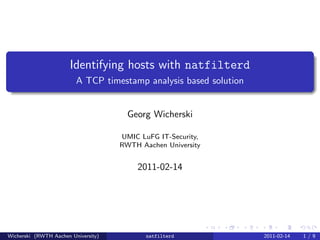
Identifying hosts with natfilterd
- 1. Identifying hosts with natfilterd A TCP timestamp analysis based solution Georg Wicherski UMIC LuFG IT-Security, RWTH Aachen University 2011-02-14 Wicherski (RWTH Aachen University) natfilterd 2011-02-14 1/9
- 2. Motivation SNAT 1 makes individual host identification hard All hosts behind the same SNAT gateway appear to have the same IP address In Capture-the-Flag contests2 , SNAT is used to mix other teams’ hosts and the gameserver to prevent trivial traffic filtering of opponent teams’ attacks We need to identify individual attacking hosts and drop their traffic Some people use botnet sinkholing3 to estimate the size of a threat Hosts behind SNAT are counted as a single infection if no application layer ID is available 1 Source Network Address Translation 2 http://www.cipher-ctf.org/CaptureTheFlag.php 3 e.g. http://www.cs.ucsb.edu/~kemm/courses/cs177/torpig.pdf Wicherski (RWTH Aachen University) natfilterd 2011-02-14 2/9
- 3. TCP Timestamps The TCP protocol allows for options in the header (RFC 793) TCP timestamps are such an extension option to optimize performance (RFC 1323) Wicherski (RWTH Aachen University) natfilterd 2011-02-14 3/9
- 4. TCP Timestamps The TCP protocol allows for options in the header (RFC 793) TCP timestamps are such an extension option to optimize performance (RFC 1323) Support is indicated by supplying a timestamp option header with zero timestamp If both hosts support it, timestamps are exchanged Wicherski (RWTH Aachen University) natfilterd 2011-02-14 3/9
- 5. Timestamp Generation RFC 1323 – 3.3 The RTTM Mechanism The timestamp value to be sent in TSval is to be obtained from a (virtual) clock that we call the ”timestamp clock”. Its values must be at least approximately proportional to real time, in order to measure actual RTT. Wicherski (RWTH Aachen University) natfilterd 2011-02-14 4/9
- 6. Timestamp Generation RFC 1323 – 3.3 The RTTM Mechanism The timestamp value to be sent in TSval is to be obtained from a (virtual) clock that we call the ”timestamp clock”. Its values must be at least approximately proportional to real time, in order to measure actual RTT. TSval = (wallclock − boottime ) ∗ tickscale host specific kernel specific Wicherski (RWTH Aachen University) natfilterd 2011-02-14 4/9
- 7. Fingerprinting Hosts First documented in Phrack #63 0x03-2: “TCP Timestamp To count Hosts behind NAT” Track TCP connections: each packet belongs to the same host Approximate linear regression equation y = c0 + x ∗ c1 from set of points (wallclock, TSval) If distance to next host equation below threshold, update old equation Otherwise add new host to database Once a host is in the database, try to match new packets against it in realtime Wicherski (RWTH Aachen University) natfilterd 2011-02-14 5/9
- 8. Fingerprinting Hosts First documented in Phrack #63 0x03-2: “TCP Timestamp To count Hosts behind NAT” Track TCP connections: each packet belongs to the same host Approximate linear regression equation y = c0 + x ∗ c1 from set of points (wallclock, TSval) If distance to next host equation below threshold, update old equation Otherwise add new host to database Once a host is in the database, try to match new packets against it in realtime Without optimizations: O(n2 ) for adding n hosts with significant c for distance calculation O(n) for matching one packet against n host with significant c Wicherski (RWTH Aachen University) natfilterd 2011-02-14 5/9
- 9. Introducing “Rate Classes” TSval = (wallclock − boottime ) ∗ tickscale host specific kernel specific Windows: Apparently uses kernel equivalent of GetTickCount() 1 Linux: Uses jiffies, incremented every HZ seconds Common values for HZ are 100, 250, 1000 OpenBSD, FreeBSD, NetBSD: Did not test Finite and sufficiently small set of r different values for tickscale Round value to 0.01ms granularity / resolution Wicherski (RWTH Aachen University) natfilterd 2011-02-14 6/9
- 10. Optimizations by “Rate Classes” x2 − x1 dist = sin (tan−1 (tickscale)) Wicherski (RWTH Aachen University) natfilterd 2011-02-14 7/9
- 11. Optimizations by “Rate Classes” x2 − x1 dist = sin (tan−1 (tickscale)) Algorithm for finding host for connection O(log2 n) min ← ∞ rateclass ← rateclasses.hashlookup(round(tickscale)) neighbours ← rateclass.btree(xnormalized ) {O(log2 n)} for all neighbour ∈ neighbours do if dist(neighbour .x, xnormalized , rateclass.rate) < min then min ← neighbour , dist end if end for return min Wicherski (RWTH Aachen University) natfilterd 2011-02-14 7/9
- 12. Optimizations by “Rate Classes” (contd.) Algorithm for matching single packets O(log2 n) min ← ∞ for all rateclass ∈ rateclasses do neighbours ← rateclass.btree(xnormalized ) {O(log2 n)} for all neighbour ∈ neighbours do if dist(neighbour .x, xnormalized , rateclass.rate) < min then min ← neighbour , dist end if end for end for return min Wicherski (RWTH Aachen University) natfilterd 2011-02-14 8/9
- 13. natfilterd DEMO Wicherski (RWTH Aachen University) natfilterd 2011-02-14 9/9
- 14. natfilterd DEMO Questions? Wicherski (RWTH Aachen University) natfilterd 2011-02-14 9/9
